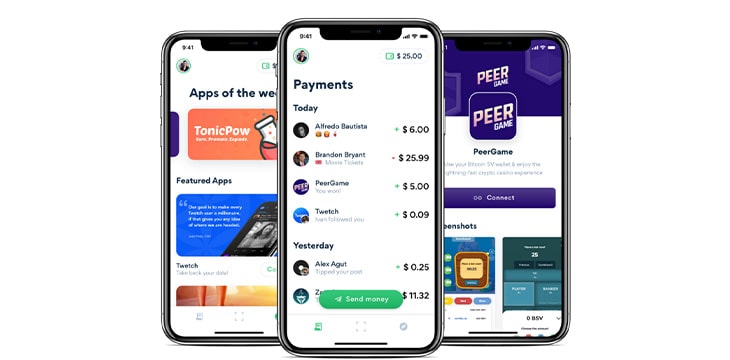|
Getting your Trinity Audio player ready...
|
This post originally appeared on the ZeMing M. Gao’s website, and we republished with permission from the author. Read the full piece here.
Bitcoin should be spent as cash. That is the original intent of Satoshi Nakamoto for Bitcoin, and also the continued design and effort by Bitcoin SV (BSV).
In fact, Bitcoin should be spent much more commonly, frequently and ubiquitously than paper cash.
However, for a practical reason, it should not be spent on the surface, but rather be spent behind the scene, almost invisible to regular users.
Consider the following mode of payment:
- An item is priced in a fiat currency. A buyer buys the item from a seller.
- The buyer (payer) and the seller (payee) each have a BSV-supported wallet, which supports an option of holding and displaying balances and prices in a fiat currency of choice, instead of BSV.
- Buyer makes a payment using the wallet for the price of the item.
- In making the payment, the payer’s wallet automatically and invisibly converts an amount of fiat equivalent to the price to BSV, and sends the BSV to the payee’s wallet, where the BSV is, optionally, converted to payee’s fiat, also automatically and invisibly.
All this can happen instantly in the back-end. In performing this function, Bitcoin (BSV) does not even have to be visible, much less used in actual pricing, which can be done by any suitable fiat currency. The users see everything in fiat only (assuming that is the mode elected by the user).
In the above scenario, because BSV enables instant settlement, volatility is irrelevant even if BSV is volatile in a larger time-frame. The instant settlement ability of BSV serves as a global settlement medium, as well as a liquidity medium.
This is what Ripple wishes its XRP to be, but they don’t even have a true blockchain.
But why?
Why do you want or need to hide BSV in the payment process?
It is because currency is language, and speaking a foreign language is hard.
There is a reason why the very logically designed language Esperanto (claimed as the “world language”) never caught up.
That is, in the early stage of the Bitcoin adoption, it is strategically and practically necessary to allow people to still use their local currency, while have Bitcoin working behind the scene as a hidden “translator” to solve the problems that are caused by the different local and foreign currencies.
It doesn’t matter what theoretical and technological arguments you make, people will only spend in a currency which they are familiar with (at the present time, that can only be a local currency), because that’s the language they speak.
Few people in this world are truly bilingual, and when it comes to money as a language, much fewer still.
But there’s an even more fundamental reason why it is extremely hard for a new language to be spoken: the reverse network effect.
When one speaks, not only must the person have the ability to speak the language, but his audience must also speak the same language. Learning a new language is hard enough already, but with a new language that is just invented, it is much harder to find someone to speak the same language.
This basic negative network effect reduces the opportunity chance exponentially. That is exactly why the very logically designed “world language” Esperanto never caught up.
The Bitcoin community has always lacked this understanding, partially because of the BTC community’s inclination of being idealistic instead of practical.
So let’s be practical. Allow people to speak their local languages, and let BSV be the unheard translator.
Don’t seek “face,” seek service (utility).
With a wallet that is built on the BSV chain, but automatically converts, all behind the scene, between BSV and a local currency, the user feels like he’s spending/receiving local money, but in fact everything is happening on the chain (with all the Bitcoin blockchain advantages).
Another explanation
The above “faceless” design for BSV-based payment is essentially using the BSV as a settlement medium only, not a full payment medium.
There is a difference between a “payment medium” and “settlement medium.” The real Bitcoin (BSV) is designed to be at least a “settlement medium.” If it can also serve as a “payment medium,” it would be a huge plus, but if not, it is still fine.
One important property that BSV does have is its ability to have instant settlement, by which it may serve as a “settlement medium” with or without a fiat environment. It works especially well in a cross-border multiple fiat environment or a cross-platform multi-token environment.
To do that requires it to be vastly scalable (which BSV is, but BTC isn’t).
A road from a settlement medium to a full payment medium
The above “faceless” design for BSV-based payment is just a conservative proposal, as the least invasive or least disruptive approach to the existing fiats. It is strategically necessary, but it may only need to be transitional, because with an extremely efficient settlement medium, what will prevent it from eventually becoming a full payment medium?
Already, for non-conventional merchandises that are created and traded in the digital-verse, pricing using a BSV unit (such as Duro) can already work realistically. To the extent that such pricing happens, BSV becomes a full payment medium. A new world of merchandising is rising, and the old is also being transformed.
Q&A
Question: with local currency fluctuations and Bitcoin fluctuations, you would never know what a loaf of bread is actually costing you when you buy it.
Answer: In terms of knowing the actual cost of the bread, the above proposal is not different from what people have now. If you buy a loaf for $1 (an example of local currency), that is the price you know you are paying, and no more knowledge is necessary.
The possibility that the local currency might be so unstable that people can’t even use it to get a sense of real cost (in spite of knowing the currency unit number of the cost), that’s a whole different situation. At any given time, very few countries experience that kind of a situation.
For people who are in that situation, an option should be given for the users to deliberately choose Bitcoin (BSV) as the face payment, so that both the pricing and payment are in BSV, requiring no fiat conversion.
However, instead of contemplating extreme situations, it is more important to address a much more basic issue of practicality.
The bottom line of what I am trying to say is that, having the mass adopting a completely new currency is as hard as suddenly asking a people to start to speak an entirely different language. It is not going to happen easily.
Imagining that people will quickly adopt a cryptocurrency on its face is really a result of the persistent influence of the pernicious anti-government ideology of the Bitcoin Core (BTC), who would like people to start immediately to measure all value using BTC. They take pride in promoting the idea, because they think it is profoundly revolutionary. It is pride, a hallmark of that group.
Question: If I buy something for $10 in “translated” Bitcoin, the next week it could be $5, then the next week $20. My effective salary would go from $2,000 to $1,000 then $4,000. Not exactly helpful!
Answer: In the above proposal, regular users only “translate” a fiat currency to bitcoin at the moment of transaction. The regular users do not buy bitcoin to keep them for any definite time. Only conscious investors do that.
Say you are a fiat user not interesting in investing in Bitcoin. You put $100 in your wallet. Your dollars do not become Bitcoin at the time of your deposit. They stay as dollars (your original currency) in your wallet. Next, you pay $10 to buy something. The $10 automatically converts to the equal amount of bitcoin based on the market price at the moment, and the converted Bitcoin is transmitted over the Bitcoin network (BSV, to be efficient) to the wallet of the payee. If the payee is also a fiat user (i.e. not interested in bitcoin itself), the Bitcoin received is automatically converted to his preferred local currency, and it does not have to be the same as the payer’s currency.
All above happens behind the scene without requiring the users to do anything, not even seeing what’s happening in the backend.
With this design, the value of the users’ money is not affected by the fluctuation of the Bitcoin at all, because the transaction can be finished within just a few seconds. This way, regular users don’t even realize that they are using Bitcoin. But the entire inner-working of the system is not the traditional banking system, but the Bitcoin network.
An option to be visible
The system may have the option of investing in and holding bitcoin for those who want to do so.
There may be fewer than 1% of the users are actually interested in keeping Bitcoin. The majority may not be even interested in the story of bitcoin, much less holding it, but only want to take advantage of convenience and efficiency of the tool.
But that is all right. The majority users are contributing to, and being benefited by, the Bitcoin network without knowing it.
The success of an asset (say, BSV) does not depend on its investors, but on its users. This is important. The majority users, even if indifferent to Bitcoin and the technology, are more important to Bitcoin’s success than they appear to be. In fact, they are more important than the Bitcoin investors and enthusiasts.
It is a mistake to focus on the investors of the coin. This is not to say that the investors are not important, but just to acknowledge a secret in life: You don’t always benefit yourself by directly promoting your own interest. You benefit yourself in long-term when you serve the interest of others.
Learn more about Bitcoin investments with this new ebook, Investing in Blockchain: Better data for a better world.

 12-21-2025
12-21-2025 




